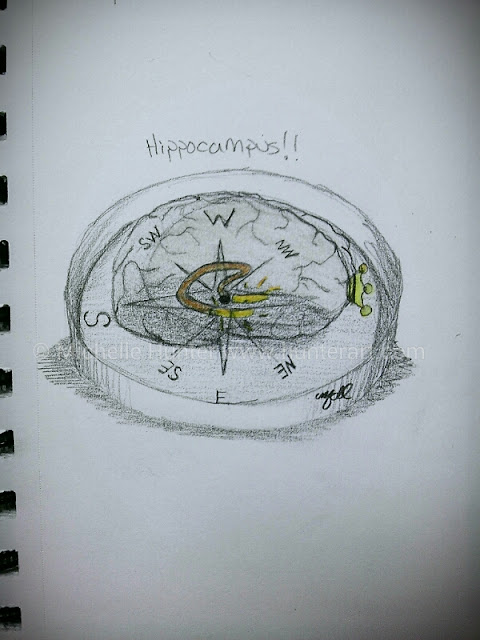I Want
20" x 24"
Acrylic on stretched canvas
While depression was already a topic in my Brain Series queue, starting it was sparked by the death of a good friend who suffered from depression. Finishing it took a good amount of will from me.
What Could I Do?
This experience for me was a shock and got me thinking. We all have ups and downs, yet why do some of us struggle with building ourselves back up during the downturns? Think about how many people you interact with on a regular basis where things seem like they are fine. Perhaps some people you know say that things will be fine and put on a brave face while they may be spiraling downward inside? How would you know that they are going through this internal battle when on the surface, things seem fine-when you probe and show concern but you aren't getting an honest response?
The Composition
 The questions above led me to want to have a mask in the composition of the painting. The mask in the painting is of a smiling face while the person is instead feeling detached. Will the person put the mask on and put on an appearance that all is fine or will they or show/express how they really feel?
The questions above led me to want to have a mask in the composition of the painting. The mask in the painting is of a smiling face while the person is instead feeling detached. Will the person put the mask on and put on an appearance that all is fine or will they or show/express how they really feel?I wanted the scene to be a social setting and chose a restaurant where people are coming and going or having a meal or drink with the person they are with. Also the large windows show people going about their business, the world doesn't stop for anyone, life goes on.
 I ended up painting someone outside the place looking into the restaurant. While I was working on the rest of the painting, I felt fine not painting a face on her. In the end, I chose to leave her without a face. Make of it what you will.
I ended up painting someone outside the place looking into the restaurant. While I was working on the rest of the painting, I felt fine not painting a face on her. In the end, I chose to leave her without a face. Make of it what you will.In the painting, I painted the brain as an MRI scan so you can see where the outline of the cortex is (it's the white outline and explained later in the "Research" section below). There are parts of the outline that are thinner than others which is what it could be like for someone suffering from, or likely to develop depression.
Research
My research on the topic lead me to a NY Times article on a study that looked into the family history of depression. Thinning of the cortex appeared to be a trait of those susceptible to developing depression. While there are numerous articles on the topic, this one shaped the angle I approached for the painting. I found it interesting that parents that are depressed could unknowingly pass along traits of the illness to their children. It's still to be determined whether it is passed via genetics or if it is just a byproduct of the children's environment or a combination of both.
Some In Progress Pictures
You're welcome to use any of the means below to let me know what you think. It's important to share and be honest if you are comfortable doing so.
Regards,
Michelle Hunter
Contemporary Artist
Tel: (646) 504-5034
www.hunterart.com
info@hunterart.com
---------------------------------------------------------------------------------------------
Get a FREE handwritten postcard from me! Join my mailing list here: http://bit.ly/HunterArtList
Contact me to commission a painting or drawing (info@hunterart.com / 646-504-5034)
The Brain Series of Paintings, so far: http://hunterart.blogspot.com/p/brain-paintings.html
Purchase prints to fit your space here: http://www.hunterart.imagekind.com
Like on Facebook: http://www.facebook.com/hunterart
Follow on Twitter: http://www.twitter.com/artcoholic
Follow on Instagram: http://www.instagram.com/hunterart
--------------------------------------------------------------------------------------------






